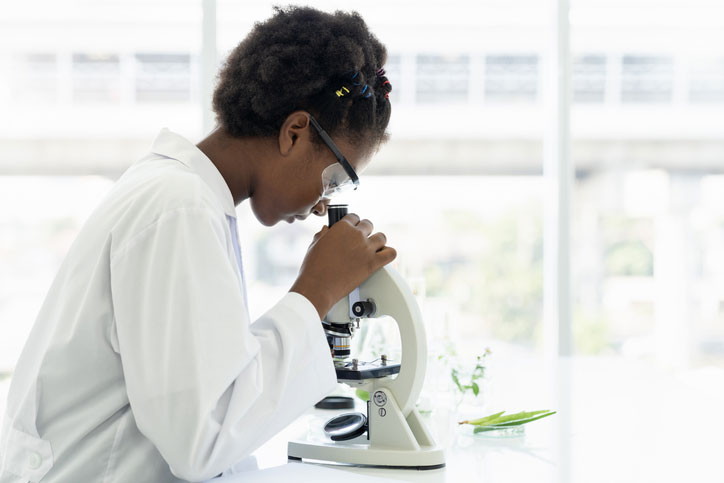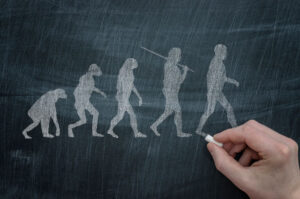

Biology is the study of life. As a term originally coined by the ancient Greeks, it fits naturally in the syllabus of any liberal arts degree program. And since the liberal arts are all about achieving a universal understanding of the world around us, who we are, where we come from, and where we’re going, you actually need a basic understanding of biological science to even begin to explore those questions.

Designer Babies and Augmented Humans in the Brave New World of Biological Science
 The ability to edit specific genes has only just recently become possible, but has already gained a lot of notoriety with the Nobel Prize awarded for CRISPR in 2020. As our understanding of genetic sciences deepens, it portends important moral, philosophic, and religious questions for the future. Wrestling with the ethical dilemmas around gene editing, and the social issues that will inevitably arise from income disparity affecting equal access to genetic enhancements will fall to today’s liberal studies students to figure out. Only someone with a background in the liberal arts and sciences can bring an understanding of science, philosophy, religion, culture and history to bear on these questions.
The ability to edit specific genes has only just recently become possible, but has already gained a lot of notoriety with the Nobel Prize awarded for CRISPR in 2020. As our understanding of genetic sciences deepens, it portends important moral, philosophic, and religious questions for the future. Wrestling with the ethical dilemmas around gene editing, and the social issues that will inevitably arise from income disparity affecting equal access to genetic enhancements will fall to today’s liberal studies students to figure out. Only someone with a background in the liberal arts and sciences can bring an understanding of science, philosophy, religion, culture and history to bear on these questions.
Biology’s impact on science, philosophy, religion, culture and history makes it a perfect subject for the liberal arts, and there’s no more exciting time to study it than the present.
The Liberal Arts and Sciences Cover the Evolution of Biological Science Through Culture and History
History and culture have played an important role in shaping biological science as we know it today. The study of biology stretches back 5,000 years to the first civilizations in the Middle East, and traces a long series of developments through the ancient Greeks, Taoist China, Ayurvedic India, the medieval Islamic world, all the way through to the Age of Enlightenment in Europe on up to present day.
Every human culture, even prehistoric ones, have placed a premium on developing methods and rituals to heal and improve human biological health; in other words, they all practiced medicine. There are also extensive historical records from civilizations across the globe describing their endeavors to understand the natural world around them.
Among the first civilizations, ancient Egyptians developed an understanding of human anatomy to the extent that they were able to treat bone fractures and perform simple surgeries. Mummies x-rayed with modern technology show healed bones set into place. What’s found today in a surgeon’s toolbox –forceps, sharp knives, pincers, and drills– are among the tools found in the tomb of the Egyptian doctor Qar who lived over 4,000 years ago. The insights the Egyptians gained were spread to ancient Greece, Persia, and throughout the rest of the Middle East.
The notion of evolution is foundational to biology. However, that and other pivotal points of understanding are not all modern discoveries:
- The idea that humans resulted from a creature that crawled out of the water and adapted itself to live on the land is recorded in the works the Greek Anaximander of Miletus, who lived over 2,500 years ago.
- Eighth century Muslim theologian and thinker Al-Jahiz who grew up in Basra of modern-day Iraq wrote one of the first books that can be described as a biological compendium on animals and expresses the concept of survival of the fittest.
- Ibn Khaldun, a native of Tunis, wrote one of the first descriptions of evolution noting that plants progressed from minerals and animals progressed from plants. That was in the 14th century about 400 years before Darwin.
While Western thought tends to place the development of biology in Enlightenment Europe, a liberal arts perspective takes into account biology’s rich history that draws from ancient empires and different cultural and religious understandings about the nature of life.
The Invention of the Microscope and Discovery of Microbiology Has Roots in the Liberal Arts and Sciences
 In 1492 present-day Spain successfully implemented its Christian Reconquista, driving out all Muslim Moors and Sephardic Jews from the land. Rendered homeless, many went to present-day Italy, taking with them the 1,000-year-plus accumulated knowledge of successive Caliphates. Preserved among their books were Islamic advances in the sciences and Arabic translations of the works of the Classical Greeks, which itself had drawn from the thoughts of their forebearers and neighbors including the Assyrians.
In 1492 present-day Spain successfully implemented its Christian Reconquista, driving out all Muslim Moors and Sephardic Jews from the land. Rendered homeless, many went to present-day Italy, taking with them the 1,000-year-plus accumulated knowledge of successive Caliphates. Preserved among their books were Islamic advances in the sciences and Arabic translations of the works of the Classical Greeks, which itself had drawn from the thoughts of their forebearers and neighbors including the Assyrians.
This wealth of knowledge was gradually translated in Italy and gave birth to the Renaissance. By the 16th century thanks to inventions like the printing press, the Protestant Reformation had taken hold as a challenge to Roman Catholicism, creating the mental space that was necessary to make scientific advancements. This was particularly true in the modern-day Netherlands that enjoyed a Renaissance of its own. It was here that the first compound microscope was likely invented around the turn of the century, somewhere between 1590 and 1620.
The compound microscope, the first device to use two lenses instead of a single magnifying glass, revolutionized biology and ushered in a new paradigm: microbiology.
This invention is a masterpiece analogy for how the liberal arts provides an enriching framework for understanding biology. The compound microscope is not just a 17th-century piece glass and metal; it represents an idea that can be traced back nearly 3,000 years to Assyria where the first rock crystal lens existed. The Assyrians influenced the ancient Greeks, who influenced Islamic Caliphates, who influenced Middle Ages Italy, who influenced the Protestant Netherlands. It was only in this environment, when enough conditions aligned, that the compound microscope could be invented. And that’s a story best told by the liberal arts.
Culminations of the Liberal Arts and Sciences – Darwin and Mendel
Charles Darwin (1809-1882) and Gregor Mendel (1822-1884) stood on the shoulders of the accumulated wealth of knowledge that had advanced over millennia through countless cultural, political, and religious transformations. Both these individuals would have a profound effect on the path biology would take leading up to the present day.
At its peak the sun never set on the British Empire, fueled by trade in everything from slaves to spices. This was thanks in large part to its powerful Royal Navy that was able to blockade all rivals. And it was on a ship commissioned for the Royal Navy that Darwin circumnavigated the globe between 1831 and 1836, studying the diversity of species along the way and developing the theory of evolution. Darwin cemented the idea that plants and animals evolve to adapt to their unique environments over long periods of time.
The Origins of Evolutionary Biology
While Darwin’s On the Origins of Species was being published, in the modern-day Czech Republic Mendel was discovering genetics in his pea garden. Between 1856 and 1863 he selectively bred around 28,000 pea plants to realize that characteristics like height, color, and shape were passed on by parent plants to their successors in ways described as dominant, recessive, and hybrid.
Unfortunately, the world was not as connected back then as it is today, and Darwin and Mendel never crossed paths. It would take about 90 years for biologists to put their work together. Combined with what was being learned about cells thanks to the compound microscope and now its 20th-century successor, the electron microscope, the study of life was yet again poised to make the leap to its next paradigm that would dominate the century: evolutionary biology.
Today the top liberal arts colleges in the nation pay homage to the discoveries made by Darwin and Mendel. They’re honored in the first chapters of every textbook and introductions of every lecture about biology, evolution, and genetics.
It’s an Exciting Time to Study Biology as Part of a Liberal Arts and Sciences Degree Program
Just as advances in the understanding of evolutionary biology dominated the 20th century, DNA and its role in genetics is poised to dominate the 21st century. Representing today’s newest paradigm advancement in biology, computers will make strides in this field possible just as microscopes enabled the prior century’s study of cells and microscopic life.
We’re getting closer to understanding deep philosophical and religious questions:
- Can humans be reduced to a series of electrical impulses and hormones?
- Can our thoughts, memories, and emotions be entirely explained by neurochemistry?
- Or are we somehow a product that’s greater than the sum of our biological parts?
- What is consciousness?
Gene editing is going to create options that challenge ethical and moral boundaries that are well within the purview of religion:
- Is it ethical to alter an embryo’s DNA to make it smarter and stronger?
- If the answer is yes, how are we going to cope as a culture and society with what will inevitably be a two-tiered class system of enhanced and non-enhanced people?
The history and development of biology are obviously within the domain of a liberal arts and sciences education. And it’s an easy extension to say those with a liberal arts education that’s well rounded in cultural studies, philosophy, history, science and religion are desperately needed and in the best position to answer the challenging questions biology will pose in developments that are just over the horizon.




